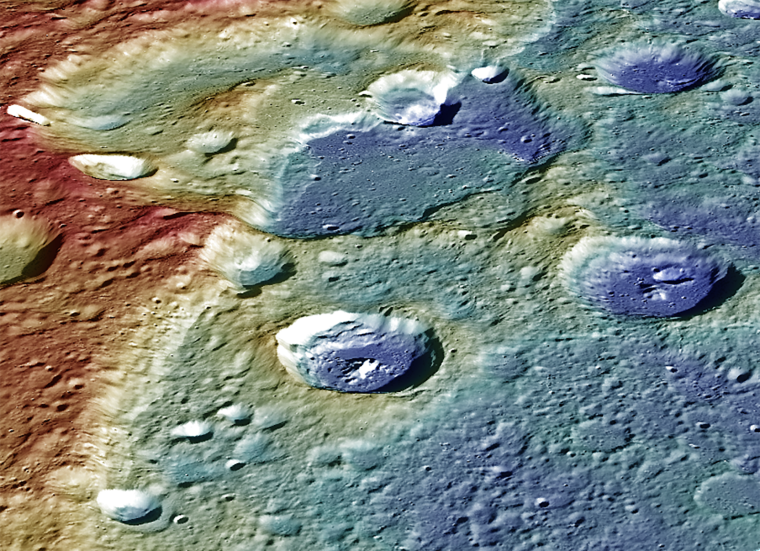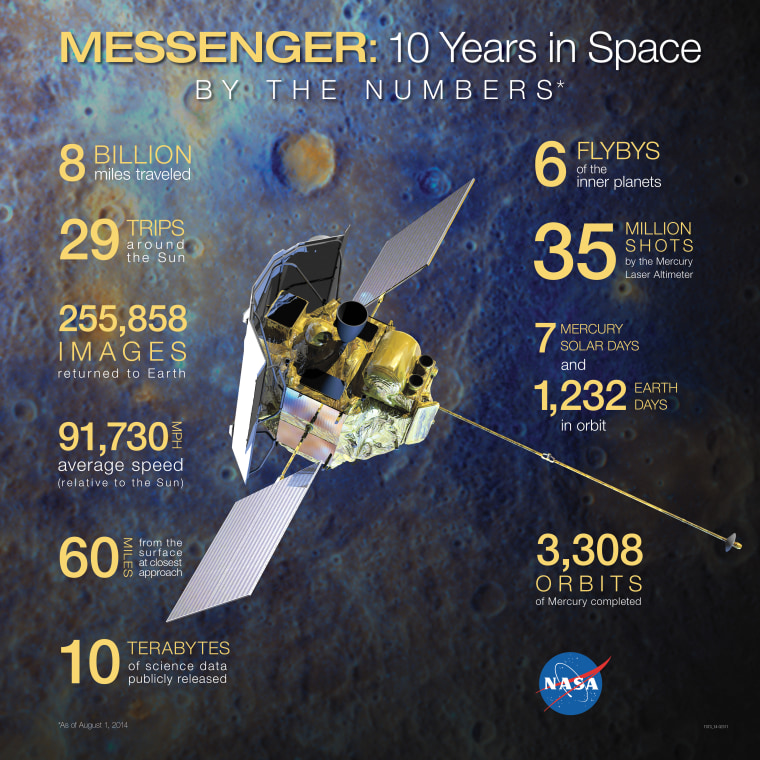Four years after its history-making entry into orbit around Mercury, NASA's Messenger spacecraft is being readied for a history-making crash on April 30.
The car-sized probe will become the first human-made object to fall to the planet's surface, after sending back an unprecedented amount of data about a realm of ice and fire. An orbital maneuver on April 24 will exhaust the spacecraft's propellant and set the stage for the end of the $427 million mission six days later, at about 3:25 p.m. ET.
The craft is expected to hit the surface at more than 8,700 mph (14,000 kilometers per hour) and leave a crater that's 52 feet (16 meters) wide. Impact is due to occur on the side of the planet facing away from Earth, and thus won't be watched by telescopes — but future orbiters could theoretically spot the scar.
"After studying the planet intently for more than four years, Messenger's final act will be to leave an indelible mark on Mercury," Daniel O'Shaughnessy, Messenger's mission systems engineer at Johns Hopkins University's Applied Physics Laboratory, said in a statement on Thursday.
Messenger was launched in 2004 and conducted three Mercury flybys in 2008 and 2009 before settling into orbit in 2011. The achievement earned the mission its own postage stamp. The only other probe to study the closest planet to the sun was NASA's Mariner 10 probe, which flew past Mercury three times in 1974 and 1975 but never went into orbit.
Brimstone and ice
Messenger's name is actually an acronym that stands for MErcury Surface, Space ENvironment, GEochemistry and Ranging. Its instruments produced the first global maps of Mercury, sampled wisps of atmosphere and confirmed that the planet had deep deposits of brimstone as well as trillions of tons of water ice.
"The water now stored in ice deposits in the permanently shadowed floors of impact craters at Mercury's poles most likely was delivered to the innermost planet by the impacts of comets and volatile-rich asteroids," said Messenger principal investigator Sean Solomon, who is also director of Columbia University's Lamont-Doherty Earth Observatory.
Such impacts also probably left behind dark, carbon-rich material that covers most of Mercury's polar deposits, Solomon said. "By this interpretation, Mercury's polar regions serve as a witness plate to the delivery to the inner solar system of water and organic compounds from the outer solar system, a process that much earlier may have led to prebiotic chemical synthesis and the origin of life on Earth," he said.

Handling the heat
During a Thursday briefing at NASA Headquarters in Washington, the Messenger team celebrated the mission's contribution to planetary science — as well as the spacecraft's hardiness in the face of temperatures that routinely ranged higher than 570 degrees Fahrenheit (300 degrees Celsius).
"Messenger had to survive heating from the sun, heating from the dayside of Mercury — and the clearest demonstration that our innovative engineers were up to the task has been the spacecraft's longevity in one of the toughest neighborhoods of the solar system," Solomon said.
The orbital mission was initially scheduled to last just one Earth year, but Messenger's team found ways to conserve the spacecraft's propellant for three years' worth of extensions — including a final one-month extension for low-altitude observations.
Although Messenger is the first spacecraft to orbit Mercury, it won't be the last: A European-Japanese mission called BepiColombo will launch in 2017 and put two spacecraft into Mercurial orbit in 2024.

